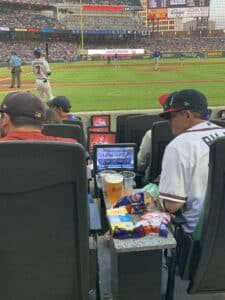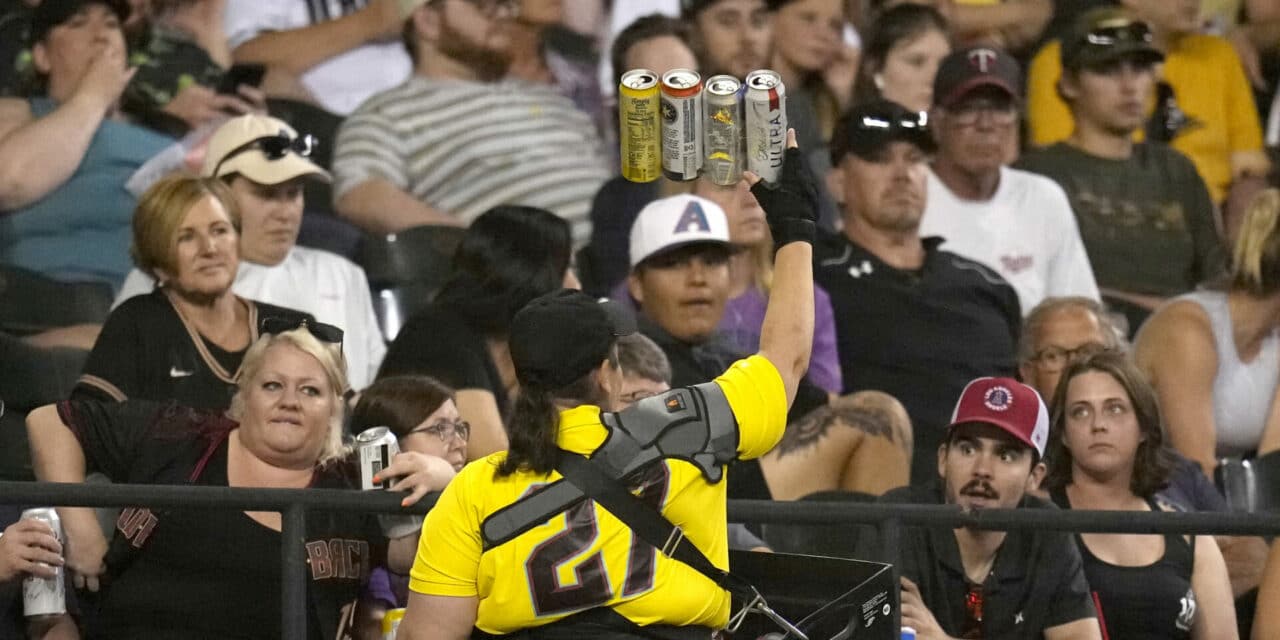LONG MAY YOU ROAM: A beer hawker with Levy walks the stands at Chase Field in Phoenix, where the Arizona Diamondbacks played the Milwaukee Brewers on April 11. (AP Photo)
Dynamic pricing, jumbo sizes, premium items part of solution
Shorter game times across Major League Baseball tied to a series of new rule changes has some teams extending alcohol sales deeper into those contests. Concessionaires and consultants say it’s still too early to identify specific trends for decreased per caps and there are a multitude of options they can apply for overcoming potential shortages in food and drink revenue.
“Teams and food operators that think they are not capturing sales due to the pitch clock should focus on points of sale and speed of service, because there is plenty of time to get fans served multiple times in the new game,” said consultant Mike Plutino, founder and CEO of Food Service Matters.
The Associated Press recently reported four MLB teams extended beer sales into the eighth inning as a test case after seeing average game times drop by 31 minutes over the first three weeks of the season, due mostly to the pitch clock rule speeding up the pace of play on the field.
The Arizona Diamondbacks, Milwaukee Brewers, Minnesota Twins and Texas Rangers are among the initial teams that made the switch, AP reported. Levy runs the food at Chase Field, home of the Diamondbacks. Delaware North Sportservice is the food provider at American Family Field, Target Field and Globe Life Field, where the Brewers, Twins and Rangers play, respectively.
In addition, the New York Yankees, in conjunction with Legends, their in-house concessionaire, have made a change by ending alcohol sales in general seating areas two and a half hours after the scheduled start of the game, or at the end of the eighth inning, whichever comes first, said Legends spokesperson Stacey Escudero. Previously, the cutoff was two hours after the game started at Yankee Stadium or the end of the seventh inning, whichever came first, Escudero said.
Teams are driving the changes, according to food vendors, who are closely monitoring sales data to determine whether those adjustments could be made permanent and whether more of their clients could make the extension.
Sportservice runs the food at 10 MLB venues.
“The early data from the first few weeks suggests we won’t see a significant revenue impact, but it’s obviously a small sample size,” Sportservice President Jamie Obletz said by email. “We’ll work with our clients and continue to be flexible as the season goes on and we collect more data on how, or if, the accelerated play affects other areas of the ballpark experience.”
Aramark is doing the same thing with its data science team, analyzing multiple factors for the nine MLB parks where it operates concessions, company officials said. In the interim, Aramark has taken steps to mitigate the impact by forming additional points of sale and availability of menu items, officials said.
Plutino said he feels some of what’s going on is an overreaction by the mainstream media, giving them something to write about. The spot checks he’s made with his MLB clients, including the Atlanta Braves, a Sportservice account at Truist Field, verify that sales are not showing a decline from last season.

BRAVING IT: The Delta Sky360 Club at Truist Field, with seats behind home plate, is an all-inclusive ticket, which helps mitigate potential shortfalls in beer sales due to the pitch clock. (Don Muret/Staff)
Bottom line, baseball fans are aren’t drinking any less alcohol at the ballpark. Beer and hot dogs remain the top selling concession items, with the exception of Milwaukee, where bratwursts are top dog. With shorter games, they’ll make the necessary adjustments, coupled with teams diving deep into sales receipts to come up with solutions, some of which they may already have in place, consultants said.
“It’s still a long event and people get up and down and step away from the game more than any other sport,” Plutino said. “Teams (and vendors) in all leagues have become more sophisticated in developing a variety of approaches to revenue optimization beyond just annual price increases, and in the post-cash world, are deploying multiple pricing strategies.”
Dynamic pricing, upgrading to jumbo size items with buckets of food, offering more cocktails and the newest souvenir cup sensation, the 26-ounce plastic beer bat, which Levy sells for $30 filled with suds at Wrigley Field, can be sold at a premium price to help make up for proposed revenue shortfalls, Plutino said. The shift to more all-inclusive ticket packages in premium spaces, strengthened by the ability to capture food and drink revenue in advance of the season, is another example of teams and their food providers’ creativity to drive higher per caps.
“Everywhere, there is an opportunity to bundle food and beverage to activate seating areas that may not have as much demand,” he said.
Most recently, the new grab-and-go marketplace concessions trending across sports venues, including ballparks, whether it’s autonomous technology or self-checkout, play an even more critical role now for speed of service and efficiency with shorter game times, Obletz said.
The bulk of concession sales still occur during the early walk-in to the ballpark through the fifth inning, said veteran consultant Chris Bigelow, founder and owner of The Bigelow Companies. By the seventh inning, which has been the typical cutoff time for alcohol sales in the past for many teams, most fans have had their fill of food and drink, he said.
Hawkers, the beer vendors roaming the stands, also help boost sales by reaching a greater number of fans, Bigelow pointed out. More than any other sport, most baseball teams have vendors in the seats that can work longer hours, get paid by commission, with incentive to earn more money than part-time employees working traditional concession stands. All told, hawkers produce 30% to 35% of total sales in baseball, he said.
Consultant Jonathan Harris, founder of JHSports+, said MLB teams could take a cue from Major League Soccer. Those teams play a sport with a relatively tight window of opportunity to sell food and drink during the 15-minute halftime break, considering many fans sit in their seats without moving about for both 45-minute halves.
As a result, teams such as LAFC, among Harris’ clients, focus on the prematch experience, encouraging their fans to arrive early to BMO Stadium to eat and drink with discount specials and enjoy the festivities 60 to 90 minutes before the event starts. For baseball, it’s a completely different game now with the pitch clock, Harris believes, so it’s all about driving a change in fan behavior with shorter games, Harris said.
“Teams are going to have to monitor things outside of strictly dollars and cents,” Harris said. “Everyone wants to think their data team is the best. Let’s see who can crack the code here. Last call is now 30 minutes earlier and that’s a big deal. What can teams do to get people to the ballpark early? That’s where you’re going to make up time and money.”







